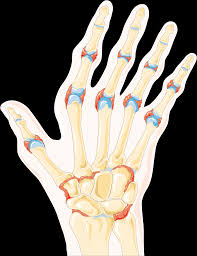Studies of blood samples from four rheumatoid arthritis patients collected over years has led to the discovery of an RNA profile that predicts an imminent flare-up of symptoms, according to a report in the New England Journal of Medicine today (July 15). The transcriptional signature also indicates that a type of fibroblast previously linked to the disease becomes enriched in the blood before migrating to the joints to wreak havoc.
“The work is clearly a breakthrough in how patients with [rheumatoid arthritis] might be managed in the future,” Lawrence Steinman of Stanford University writes in an email to The Scientist. If such an RNA test were commercially developed, then “via a home test involving a mere finger stick, markers that precede a flare [would be] identified. This would allow the individual to consult with their physician and take necessary measures to avert such a flare,” continues Steinman, who studies autoimmune diseases but was not involved in the study.
Rheumatoid arthritis, in which the body’s immune system attacks the joints to cause swelling, stiffness, and pain, exhibits a waxing and waning of symptoms, as do many other autoimmune diseases. Even with treatment to suppress certain immune cells or cytokines, it is common for a patient to experience a couple of relapses each year, says study author Dana Orange, a clinical rheumatologist and researcher at Rockefeller University in the laboratory of Robert Darnell.
Relapses in the disease are debilitating and can make life hard to plan, explains Orange. Patients “just don’t know when they are going to be blind-sided and incapacitated with a flare,” she says. Orange, Darnell, and colleagues therefore sought a way to predict such occurrences.
Being a dynamic molecule, RNA “lends itself to profiling changes over time,” says Darnell, whose research focuses on RNA regulation in autoimmune and other diseases. “What we wanted to do,” he says, “was to design a study where we could have the RNA before a patient gets sick with a flare . . . to try and get signatures of what might be the antecedents.”
To this end the team recruited patients, via an ad in a newspaper, who were willing to collect tiny samples of their own blood—a few drops via a finger stick—each week and keep diaries of their symptoms. The patients also had clinical evaluations once a month.
The team then sequenced the messenger RNA content of a selection of the blood samples—those representing baseline conditions and the weeks immediately prior to, during, and after a flare—to see whether and how the transcriptomes varied with the waxing and waning of symptoms. A total of 162 samples, taken from four patients over the course of one to four years, were sequenced and analyzed computationally.
When they looked at the weeks preceding a flare up, “what jumped out was that something changed from the baseline,” says Darnell. Two weeks prior to a relapse, the team detected a change in the RNA profile that was consistent with an increased abundance of immune cells. “That gave us a hint that we were on the right track and that was exciting,” says Darnell, “but the big excitement came when we were looking at week -1.”
“There was a unique set of genes that were unexpected—they had signatures of stem cells and mesenchymal cells,” Darnell continues, and “it was not clear exactly what to make of that.”
To figure out what the mystery cells producing these transcripts might be, the team compared the pre-flare RNA signature to signatures previously reported for a range of cell types associated with rheumatoid arthritis, including immune cells and fibroblasts.
“Boom,” says Darnell. The week -1 RNA signature “was a pretty good match” to a type of inflammatory fibroblast previously identified as aggressors in the joints of patients. “But we were seeing them in [the] blood before the patient actually got sick,” he says.
Indeed, when the patients were in the midst of a flare, the signature was no longer seen in the blood, suggesting the cells producing these RNAs may have migrated to the joints by then.
A search for the presence of these fibroblasts in the blood of a further 19 rheumatoid arthritis patients and 18 healthy people showed that, while in some patients the levels of the cells were similar to those seen in healthy controls, as a group, the patients tended to have more of them. In this experiment the disease status of the patients was unknown so it potentially included those with both waxing and waning symptoms.
Isolation and sequencing of these fibroblasts from the blood also revealed that they possessed the pre-flare RNA signature. The team calls the cells pre-inflammatory mesenchymal cells, or PRIME cells.
“One of the frustrations has been the inability to study this cell lineage without performing invasive procedures like joint biopsies,“ says rheumatoid arthritis researcher Gary Firestein of the University of California, San Diego, who was not involved in the research. “So, the notion that you could study the precursors of these cells in the in the blood . . . is extremely exciting.”
Although only a relatively small number of patients were analyzed, says Firestein, the study was “a fairly heroic effort that demonstrates the feasibility of following patient transcriptomes longitudinally,” and “a critical first step” toward developing treatments. The next steps, he says, will be “to expand the dataset and to investigate more precisely what pathways and genes are expressed, and how they participate in these cells as they emerge in the blood.” Once that is known, he adds, “you can begin mining the data to look for potential therapeutic targets . . . [to] intercede and prevent a flare.”







